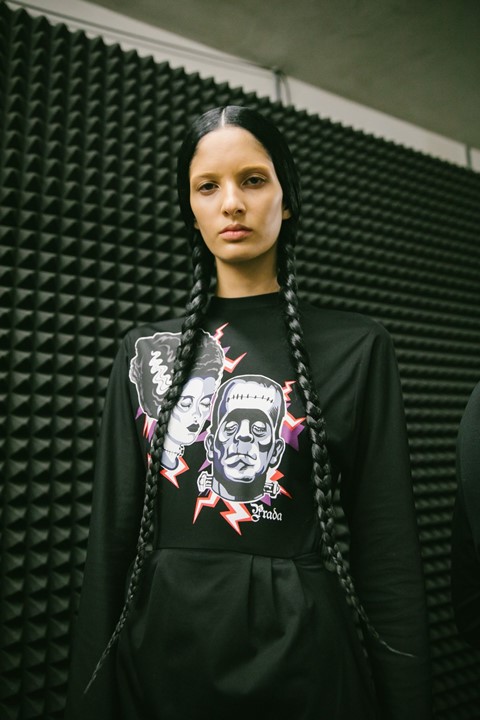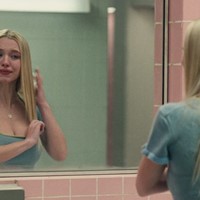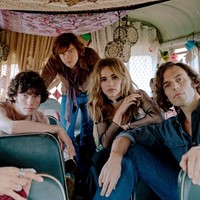From McQueen’s final Plato's Atlantis show to the supersized bouffants at Valentino's Fall 2018 Couture, Guido Palau is the mastermind behind some of the most influential hairstyles in modern fashion
In our series Icons we profile the individuals behind some of the greatest beauty images of all time, looking back on their work and forward towards their enduring influence and legacy.
For decades, hair stylist and Redken’s Global Creative Director Guido Palau has been creating some of the most provocative styles the industry has ever seen. Campaigns, runway shows, magazine covers – you name it he’s done it. Some of Palau’s work is so creative it requires more than a week’s worth of work in advance of the actual runway show. Take, for example, Marc Jacobs’ spring 2019 show, where Palau dyed 35 models’ hair to pastel shades such as pink and periwinkle. “That show is a pure fantasy about colour; antique colours. Peaches, greys, and wrung out blues and greens. To me, they're like antique colours. They're more like old lady colours, things, not from a past but, somewhere where they look very modern as well,” he tells me. It was a ten-day process all in all.
Growing up in the countryside just south of London, Palau started working at Vidal Sassoon after he finished school in the 1980s. “I remember, when I was younger, I used to do dress up,” he says. “It's part of growing up, in a way, to play with hair and make-up and clothes, and you begin to identify who you are or who you want to be that evening. That's a great thing about fashion, isn't it? It's almost something we've forgotten in a way, that it can be a play thing or a fantasy thing.”
Many credit the hair Palau did for George Michael’s now iconic Freedom video, starring Naomi Campbell, Linda Evangelista, Christy Turlington, Tatjana Patitz, and Cindy Crawford, as his big break. When Calvin Klein saw Palau’s grungy, effortlessly cool work for David Sim’s street style photos for The Face around the same time, Klein commissioned him to create a similar look backstage on the heads of Kate Moss and other major models for the fall 1994 show; thus propelling him into the spotlight as a go-to artist for the modern grunge look.
Today, Palau has mastered the best of both worlds: the odd, sculptural and art-driven coifs for Prada and Marc Jacobs, alongside the more subdued strands of Ralph Lauren, Tory Burch and the like. His overarching message when creating standout hair? “You can have curly hair, you can have messy hair. It's got to the point where you can have any hair, it doesn't matter. There's no rules anymore. We know you can dress up, you can be natural. I don't think it will ever go back to women all sitting in a salon and having big hair done, which it probably was in the '50s and '60s.”
As a stylist who frequently creates gravity-defying hair that verges on art, Palau takes inspiration from many different genres. “I started in the early '80s, so power hair was around. Also, I look at references of fashion picked up from the '60s, Diana Vreeland’s period of bizarre in Vogue. That was all extreme,” he says, recalling his early aesthetic. “She, as an editor, brought extremity to fashion, whether it be a big nose or a long neck or big hair. Everything had to be extreme.” One of the best recent examples of Palau’s work that exemplifies that boldness, was the heavens high hair he created for Valentino fall 2018 couture. “I was actually quite surprised what kind of reaction it had, to be honest,” he says. “People really loved it and it got so much traction. I did so many interviews about it. Still, people are asking me about it. Kaia Gerber actually said she'd never had so many questions about it from everyone.”
But that massive, volume-heavy hair is actually part of a larger message that Palau has been promoting for the past few seasons, if not years, behind the runway’s curtain. “There seems, for a few years, to be a break down of some beauty rules,” he says. “We have this celebration of each girl, of who they are, which is really great, but in a way after a while, you're like, ‘Okay I've seen her. I've seen it like that.’ And I've done shows after shows where it’s been much more a fantasy type of idea about fashion, which we haven't really seen for a while. It seems to be maybe a turning tide.” Take, for example, the aforementioned customized pastel patinas for Marc Jacobs’ spring show, or the Wednesday Addams style braids, baby bangs or bobs, each chosen specifically for each model at both Prada and Miu Miu’s fall 2019 shows.
“I still get very nervous about a show. I still worry about it, I still have sleepless nights,” Palau says, shaking his head. “Still, because I care about it. It's not about what I did for the last 25 years, it's what I'm doing today, tomorrow, the next day that's important. I could sit and we could talk about all the shows and all the memories, and all that, it's part of my whole thing and it informs where I am now, but it doesn't make it any easier. It almost makes it more difficult. I think when you've had a long career at quite a good level. In a way, it puts more pressure. People have a higher expectation, and then you have a higher expectation on yourself.”
But that isn’t to say Palau doesn’t take pride in some of his most iconic styling moments over the course of the last few decades. “I suppose shows that stick out are ones that were marks of where I was in my career,” he explains, citing early Helmut Lang shows back in the '90s as some of his favourite memories. “It's quite funny to think you were part of something that people are referencing and your hairstyles back then. I suppose the early Helmut Lang shows were exciting because it was the way it was presented, the girls, the mixture of girls. Very similar today, in a different way. It was a mixture of old and young girls and men in shows. That was quite new back in '92 and '93.”
Palau was also the hand behind the late Alexander McQueen’s surreal and visually arresting beauty moments backstage. “A lot of my work that I did with Alexander McQueen is very poignant to me,” he says. “He showed me a different way of looking at beauty. He had a very specific idea of women, which was celebratory but in a way that was very powerful. The women were powerful. They were not misogynistic. They were so restrictive, in a way, but he was really celebrating women's power in a different way. He was very pro-women. The beauty aesthetic was very extreme. He taught me that.” For McQueen’s final show, titled Plato's Atlantis for spring 2010, Palau created extreme chignon fins coming out of models’ head. “It was such a perfect vision, with the computers and nature and nurture. The hair was extreme. The makeup was prosthetic; building up cheeks. Saying that, it's the way a lot of women look nowadays.”
Miuccia Prada is another of the visionaries that Palau regularly works with. “It's always exciting because she's such a fantastic, fascinating woman,” he says. “She's so intuitive. Obviously, she comes from a bourgeois background but she has a great take on women. She always represents women in a very, I think, feminine and sympathetic way. It's always had a mix of different cultures.” For each show, Palau sits down with the designer to chat about different periods and references as points of inspiration, as well as the set and music. Miuccia often shows him sketches during the hour-long chat. The conversation also involves make-up artist Pat McGrath, who is responsible for creating the make-up looks of each Prada and Miu Miu show every season.
But what’s most unique about working with Miuccia is her approach to seeing beauty, according to Palau. “She looks. When you've trained your eye like she has, she can see every nuance in it; where the part is, what the texture is,” he says. “Sometimes she will pick up on something that you didn't even intentionally do, and go, ‘is that, that?’ And you're like, ‘Oh, I didn't even see that bit.’ It's a common denominator in all the people I work with, be it designers or photographers or make-up. Anyone who's at the top of their game for so long, they don't rest on their laurels. They don't rest on what they did last season.”
Working with designers who opt for a more subdued look on the runway is often a more intensive process than it looks, too. “Ralph Lauren’s very inspired by movies, the '30s, the '40s; sometimes in America, sometimes England. His vision is very, not theatrical but, movie-based. He has a dream. It's nice to go into his world, and it's nice to go into some young designer's world that has a very different take on the world.”

“Every time you go and meet a designer, you learn something more,” Palau continues. “I didn't go to college or anything. All my knowledge is from other people: teachers, designers, photographers, et cetera, and talking about things, learning, and getting their reference from Miuccia, having all of her references, and you being privy to them when you go for your meetings, and then inspiring you to do work. That's what it's really taught me about different aspects of women.”
With 30+ years spent working backstage at some of the biggest runway shows of all time, Palau has also seen his fair share of changes. “At one point in fashion, it was all like you had to have a certain length hair. Now, because there are so many diverse, different beauties in a show, you don't have to fit into that. You can have hair very short and still be considered,” he says. Social media is another topic which has deeply impacted his career. Rather than wait months for a hairstyle to make its public debut in a print magazine, Palau often posts cut and colour transformation from backstage on his Instagram in real time. But he also admits there’s a darker side to it all too: “It's like nothing's enough. It's almost like it's spiralling out of control. I thought, what would happen if you took people's phones away now? It's almost incomprehensible. I think people wouldn't know what to do with themselves. That's a scary thing about it. We're so controlled by this now. It's the first thing people do when they wake up, last thing at night, middle of the night.”
And, as for what’s next for the revolutionary hairdresser, between all the early morning call times, backstage prep and magazine cover shoots, Palau’s hoping to one day get into film. “I've worked for museums; the Met and all that,” he says. “I suppose I wouldn't mind designing a movie, working with a director and researching an idea. I don't think I could work on a set for three months, but I love the collaboration, working with other creative people. It could be a theatre piece or it could be a movie, working off other people that are very creative. That's the thing I love the most in my job, working with other creative people.”




